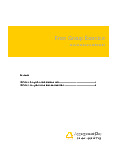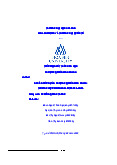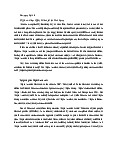



















Preview text:
MISNISTRY OF EDUCATION AND TRAINING
FACULTY OF ECONOMICS AND BUSINESS HOA SEN UNIVERSITY
INTRODUCTION TO MARKETING ANALYSIS REPORT OF
…………………………………….
LECTURER: NGUYỄN THANH LÂM, MBA.
CLASS CODE: …………. GROUP: … No. Full Name Student ID 1 2 3
MISNISTRY OF EDUCATION AND TRAINING
FACULTY OF ECONOMICS AND BUSINESS HOA SEN UNIVERSITY
INTRODUCTION TO MARKETING ANALYSIS REPORT OF
…………………………………….
LECTURER: NGUYỄN THANH LÂM, MBA.
CLASS CODE: …………. GROUP: … No. Full Name Student ID 1 2 3 i 1 TABLE OF CONTENTS
RECOMMENDATIONS OF LECTURER.............................................................................................iii
LIST OF TABLES.....................................................................................................................................iv
LIST OF FIGURES...................................................................................................................................v 1.
INTRODUCTION.............................................................................................................................1 2.
MICROENVIRONMENT ANALYSIS............................................................................................2 2.1.
The company...................................................................................................................................2 2.2.
Suppliers..........................................................................................................................................2 2.3.
Marketing Intermediaries.................................................................................................................2 2.4.
Competitors..................................................................................................................................... 2 2.5.
Customers........................................................................................................................................2 2.6.
Publics.............................................................................................................................................2 3.
MACROENVIRONMENT ANALYSIS...........................................................................................3 3.1.
Demographic................................................................................................................................... 3 3.2.
Economic......................................................................................................................................... 3 3.3.
Natural............................................................................................................................................. 3 3.4.
Technological..................................................................................................................................3 3.5.
Political............................................................................................................................................ 3 3.6.
Cultural............................................................................................................................................ 3 4.
SWOT ANALYSIS.............................................................................................................................4 4.1.
Strength........................................................................................................................................... 4 4.2.
Weakness......................................................................................................................................... 4 4.3.
Opportunities................................................................................................................................... 4 4.4.
Threats............................................................................................................................................. 4 5.
MARKETING MIX (4Ps).................................................................................................................5 5.1.
Product............................................................................................................................................ 5 5.2.
Price................................................................................................................................................. 7 5.3.
Place................................................................................................................................................8 5.4.
Promotion........................................................................................................................................9 6.
RECOMMENDATIONS.................................................................................................................13
REFERENCES........................................................................................................................................14 ii iii
2 RECOMMENDATIONS OF LECTURER
............................................................................................................................................................
............................................................................................................................................................
............................................................................................................................................................
............................................................................................................................................................
............................................................................................................................................................
............................................................................................................................................................
............................................................................................................................................................
............................................................................................................................................................
............................................................................................................................................................
............................................................................................................................................................
............................................................................................................................................................
............................................................................................................................................................
............................................................................................................................................................
............................................................................................................................................................
............................................................................................................................................................
............................................................................................................................................................
............................................................................................................................................................
............................................................................................................................................................ iv 3 LIST OF TABLES
Table 1: Table of population in Vietnam last 5 years…………………………..........……………1
Table 2: Table average income in Vietnam last 5 years....……………………………………....10 v 4 LIST OF FIGURES
Figure 1: Chart of population in Vietnam last 5 years……..…………………..........……………1
Figure 2: Chart of average income in Vietnam last 5 years....…………….….………………....10 vi 1. INTRODUCTION
Highlands Coffee is a Vietnamese coffee shop chain and producer and distributor
of coffee products, established in Hanoi by Vietnamese American David Thai in 1998. The
establishment of the Highlands Coffee company marked the first time an Overseas
Vietnamese was able to register a private company within Vietnam ………… 1 2.
MICROENVIRONMENT ANALYSIS 2.1. The company
………………………………………………………………………………………………………
………………………………………………………………………………………………………
………………………………………………………………………………………………………
……………………………………………………………………………………………………… 2.2. Suppliers
………………………………………………………………………………………………………
……………………………………………………………………………………………………… 2.3. Marketing Intermediaries
………………………………………………………………………………………………………
………………………………………………………………………………………………………
……………………………………………………………………………………………………… 2.4. Competitors
………………………………………………………………………………………………………
………………………………………………………………………………………………………
……………………………………………………………………………………………………… 2.5. Customers
………………………………………………………………………………………………………
………………………………………………………………………………………………………
…………………………………………………………………………………………………… 2.6. Publics
………………………………………………………………………………………………………
……………………………………………………………………………………………………… 2 3.
MACROENVIRONMENT ANALYSIS 3.1. Demographic
………………………………………………………………………………………………………
……………………………………………………………………………………………………… 3.2. Economic
………………………………………………………………………………………………………
……………………………………………………………………………………………………… 3.3. Natural
………………………………………………………………………………………………………
………………………………………………………………………………………………………
……………………………………………………………………………………………………… 3.4. Technological
………………………………………………………………………………………………………
………………………………………………………………………………………………………
……………………………………………………………………………………………………… 3.5. Political
………………………………………………………………………………………………………
………………………………………………………………………………………………………
…………………………………………………………………………………………………… 3.6. Cultural
………………………………………………………………………………………………………
……………………………………………………………………………………………………… 3 4. SWOT ANALYSIS 4.1. Strength
………………………………………………………………………………………………………
………………………………………………………………………………………………………
………………………………………………………………………………………………………
……………………………………………………………………………………………………… 4.2. Weakness
………………………………………………………………………………………………………
……………………………………………………………………………………………………… 4.3. Opportunities
………………………………………………………………………………………………………
………………………………………………………………………………………………………
……………………………………………………………………………………………………… 4.4. Threats
………………………………………………………………………………………………………
………………………………………………………………………………………………………
……………………………………………………………………………………………………… 4 5. MARKETING MIX (4Ps) 5.1. Product
Functions: Through researching the market, analyzing trend, understanding consumer demand,
Heineken has finally created a product that is considered as premium among the commons:
Heineken Lager Premium Quality.
Heineken is involved in brewing and marketing of premium, speciality, local and regional beer
and ciders. It is a pale lager beer with alcohol content of 5.4%. The original recipe of Heineken is
supposed to be intact and same since it was first brewed.
Specific characteristic: According to consumers’ perspective, high quality beer has to satisfy
these following conditions: featured beer flavorand, not having negative effects on the body. In
order to meet customers’ needs and enrich the experience, Heineken has managed to improve the
product’s characteristics, which in turn has helped the image and quality of Heineken beer and
solidified customers’ confidence.
Heineken beer has the following product lines in the Vietnamese market:
Heineken Lager Premium Quality:
Heineken Lager is brewed with only three ingredients – barley, hops and water – all of them
natural. Same recipe since 1873 for a beer with a crisp, clean taste. Heineken 0.0:
Heineken 0.0 is a non-alcoholic beer product (beer with 0.0% alcohol content) made from natural
ingredients, uniquely formulated to create a signature balanced flavor - and contains only 69
calories per bottle / can. 330ml capacity.
Heineken 0.0 brings consumers a new choice at all times of the day. They can enjoy Heineken
0.0 right at work, at the gym, during lunch and even just before driving - as it is a non-alcoholic 5
beer (0.0% alcohol). All those familiar moments where you couldn't have a beer before, now you can - #NowYouCan Heineken Silver 4%:
Heineken Silver - mild, easy to drink while preserving the full flavor of Heineken's world-
renowned reputation. With a perfectly balanced taste, Heineken Silver will be the ideal
companion to accompany all the fun, especially during meals, which is a popular beer drinking habit in Vietnam.
Heineken beer is available in diversified packaging like: 6 The Icon The Can Draught Extra Cold Club Bottle The Sub Draughtkeg
Logo is a special design stylized in the form of a graphic to show the image of the organization,
event or product line. It is a combination of simplicity and originality, between art and science.
In addition, it is also considered the image of the brand in the introduction of products and
services to the mass media. Brand awareness is important for Heineken to distinguish itself all
over the world. The green bottles, the star and smiling ‘e’s’ on the label all support the branding
of Heineken and brand identification among customers. 5.2. Price
From the begining, heineken has define themself as premium beer line, they want to their
products are all high qualified. So that the price is high to offset the fee they have pay for the
research, design and experiment. 7
Currently on the Vietnamese market, the price of a bottle of
Heineken is sold at a price of 15,000 - 25,000 VND.
Regarding Heinekien's pricing in the Vietnamese market,
experts have researched and given the same price because
depending on the target market that the company wants to
target, that is consumers with income. Such price is suitable
for the target customers that Heineken beer wants to target.
Heineken's price strategy has been carefully calculated and completely consistent with the
current development of the Vietnamese beer market as well as the economic development of
Vietnam in recent years. Heineken focuses on business customers, office workers, and people
with good income. Therefore, Heineken's price is quite high compared to the general level.
However, with the current growth and development of Vietnam, the increase in GDP per capita
will boost the demand for goods such as medium and high-end beer. With the development of the
market, income and life, it is clear that beer drinking no longer appears only in parties and
parties, but gradually becomes a fairly regular demand. Drinking any type of beer also becomes
an expression of the taste, social status, and style of the drinker. 5.3. Place
Beer is a popular beverage, so the distribution of beer must also ensure that the customer who
needs to buy will be able to find Heineken. Building a suitable distribution strategy will have a
huge impact on the success of businesses, especially those with retail and wholesale systems like
Heineken. With extensive distribution network, Heineken can be found in restaurants, bars,
supermarkets, and grocery stores. Since beer is a consumer commodity, the distribution channel
is quite long. Starting with general agents, then the smaller agents, the smallest distribution level
is the restaurants, the grocery stores.
In pubs and bars, Heineken has the second highest sales among lager beers after only 9 months
on the market. There are many types of beer on the Vietnamese market today, many foreign
manufacturers are also intending to penetrate the high and mid-end segment of the beer market,
so Heineken must strengthen and maintain the distribution channel system. dealers, especially
the dealer level. Heineken as well as many major brewers in the market are willing to pay
commissions to agents to keep distribution channels while preventing the entry of other brewers into their dominant regions. 8 5.4. Promotion
Heineken has a strong marketing team that promotes its products through several advertising
tools. It believes in creating catchy commercials that help in creating positive brand awareness
through electronic and print media.
Right from the beginning, Heineken’s core value that it offers to consumers is passion for quality,
enjoyment of life, respect for people and for the planet. We always advocate for responsible consumption. 5.4.1. Advertising 9
Heineken uses technology (the Internet) in promotion and advertising. Heineken website is state-
of-the-art, carefully planned and effective and SEO (search engine optimization) is effective;
meaning when you search beer, UK beer, or Heineken, it goes out and you can go to the link. The
new Heineken commercial found on YouTube is a hilarious piece of advertising that truly catches
one’s imagination and gets you to what boys really want. While the girls go for shoes and clothes
and all those stuffs, the boys go for – what else – Heineken beer. Heineken has long focused on
sponsoring sports (especially tennis), music and cinema - fields that serve the entertainment and
relaxation needs of everyone. Heineken sponsors numerous competitions of young people from
music to sports. Heineken has also repeatedly sponsored the production of major cinematic
works such as Matrix Reloaded, Bourne Identaty, Be Cool, 007- Die another day…etc, praised
by the public that loves Saturday art. 10
Heineken Vietnam is extremely focused on spreading the brand. In recent years, Heineken has
continuously invested in cult programs such as: Heineken Greenroom music event, F1 racing in Vietnam,…etc 5.4.2. Sales Promotions
Heineken has sales promotion in the forms of discounts, volume offers and contests. Customers
can buy products at a lower price for a limited time before the offer times out. These promotions
aim to enhance sales numbers since competition in the instant beer market is getting even more
cutthroat nowadays with the participation of both domestically produced brands and imported 11
brands. Discounts and volume offers can bring
back short-term benefits, but when other brands
also lower the prices to match, it turns into a very
unhealthy competition. Contests and lucky draws
are also used by Heineken to attract potential customers. 5.4.3. Public Relation
One of the typical Heineken campaigns recently is “Drinking alcohol - Don't drive” .Heineken
launched a social media campaign with the video “Solution for the Brothers” based on
psychology and practice. Vietnamese consumers' behavior. With the participation of actor Lien
Binh Phat, the video brings the idea of turning the pressure from friends on the drinking table
into support, with a series of “Solutions for the Brothers” was launched to help friends of I got
home safely after drinking alcohol. In order to assist customers in making the right decision, as
the official carrier of the program, Grab and Heineken provide Grab codes worth 100,000 VND
for free to help them get home safely later fun event.
Since its inception, Heineken®'s 2019 “Drinking alcohol - Don't drive” campaign has received a
lot of positive feedback. Within 3 days of release, the video "Solution for You" has earned more
than 1 million views with tens of thousands of positive comments and shares on social networks.
Along with the use of hashtags #UongKhongLai and #ViAnhEm, many Facebook users
simultaneously changed their avatars and tagged friends and relatives as a pledge of “Drinking alcohol - Don't drive”. 12 6. RECOMMENDATIONS
………………………………………………………………………………………………………
……………………………………………………………………………………………………… 13




